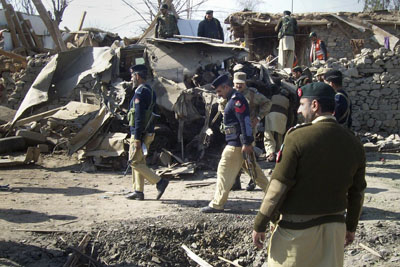Three vicious bomb blasts in Pakistan in the last two days—one in Lower Dir that wounded three reporters on Thursday, and Friday’s double attack in Karachi that we’re still investigating—highlight just how dangerous it has become for journalists, particularly TV camera crews and photographers, but certainly any journalist assigned to cover a public event or military operations in the country.
The number of attacks aimed at killing large numbers of people in Pakistan is arcing upward, and the trend doesn’t look likely to reverse any time soon.
In 2009, we ran a five-part series about the dangers facing reporters covering the story in the border areas with Afghanistan, and the tactics they are using to cope with the threats they face on a daily basis. The series was called “The Frontier War.” The final entry dealt specifically with steps that can be taken to lessen the threat to journalists.
On January 27, a respected Pakistani journalist, Zaffar Abbas, wrote to CPJ saying that TV managers in Pakistan had been able to come together to draw up voluntary guidelines about covering the increasing violence, and that the same group had begun to address the safety of the journalists covering those stories.
Abbas, the Islamabad editor of Dawn newspaper who is also on the editorial board of Dawn TV, said that the TV coverage guidelines were starting to take hold, but there was less movement toward implementing safety training or getting the proper protective gear for people in the field.
It is time for media companies to stop dragging their feet and give their frontline reporters the tools and training they need to do their jobs. Virtually all of Pakistan’s media operations are profit-making businesses. Just as those highly competitive TV stations were able to come together to agree on rules guiding their on-air coverage, they should now all come together to pledge to start investing the safety of their reporters. And the decision should not be limited to TV stations, but to all journalists—print, photo, radio, Internet—who put themselves in harm’s way to gather news. Of course there will still be losses, but the people who manage these men and women should do all they can to minimize the risks they face.
And, of course, these responsibilities also fall on the foreign news organizations covering this global story that don’t already provide the gear and training for their Pakistani staff.
Pakistan appears headed toward a new level of violence, different than what it has seen in the past. Media organizations, local and foreign, must take immediate steps to protect their staff.
I posted an update to this entry on February 8 here.
